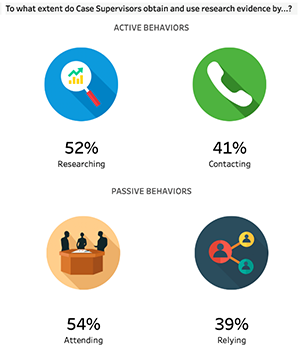Effectively Using & Sharing Data
The QIC-WD recently had the opportunity to talk with a group of human services training evaluators in Baltimore about how to effectively use and share data. The QIC-WD has a dissemination plan and data visualization experts (learn more here) to help our team and our sites use and share data for a variety of purposes. We shared the following tips to help evaluators determine what to share, when, and why.
- Plan for dissemination – that is, identify who needs the information and how best to get it to them.
- Consider who is in your target audience and how they like to receive information. The image below is an example of how child welfare case supervisors seek research evidence. Understanding that in one jurisdiction they are likely to do their own on-line searches and learn about new evaluation results by attending a meeting can guide dissemination strategies.
- Use data to inform your dissemination strategy. Survey staff to find out how they value and use research evidence; and ask who they trust for information.
- Take advantage of existing channels to share information – access the meetings, newsletters, and social media channels already relied on by the people you want to reach. This strategy can also include people (the gatekeepers and champions) who can help share your data and analysis.
- Generate buy-in/collaboration and foster meaningful relationships with those who your information is intended to inform.

- Know what you want people to do with the information once they receive it – e.g., improve their knowledge or skills.
When asked what they can do to plan for effective dissemination, evaluators highlighted the need to focus on the information needs of their target audience. Specifically, they discussed the need to think ahead about how information may be used and to “layer” it. In other words, they described strategies to package information in multiple ways (e.g., infographics, papers, videos), use different channels (e.g., social media, face-to-face meetings, newsletters), and to share it multiple times. The participants generally agreed that engaging with the end users of the evaluation to identify their intended uses of information, and design products accordingly, is a good strategy at the beginning of the evaluation process to ensure data is effectively consumed.
Check out these resources to learn more:
Cousins, J. B., Goh, S. C., Clark, S., & Lee, L. E. (2004). Integrating evaluative inquiry into the organizational culture: A review and synthesis of the knowledge base. Canadian Journal of Program Evaluation, 19, 99–141.
Government Accountability Office. (2003). Program evaluation: An evaluation culture and collaborative partnerships help build agency capacity (GAO-03-454). Washington, DC: Author.
Holton, E.F., Bates, R.A., Bookter, A.I., Yamkovenko, V.B. (2007). Convergent and divergent validity of the Learning Transfer System Inventory, Human Resource Development Quarterly, 18(3), 385-419.
Labin, S. N., Duffy, J. L., Meyers, D. C., Wandersman, A., & Lesesne, C. A. (2012). A Research Synthesis of the Evaluation Capacity Building Literature. American Journal of Evaluation, 33(3), 307–338.
Macoubrie, J., & Harrison, C. (2013). Human Services Research Dissemination: What Works? OPRE Report # 2013-09, Washington, DC: Office of Planning, Research and Evaluation, Administration for Children and Families, U.S. Department of Health and Human Services.
Milstein, B., & Cotton, D. (2000). Defining concepts for the presidential strand on building evaluation capacity. Working paper circulated in advance of the November 2000, meeting of the American Evaluation Association.
Owen, J. M. (2003). Evaluation culture: A definition and analysis of its development within organizations. Evaluation Journal of Australasia, 3, 43–47.
Palinkas, L.A., Garcia, A.R., Aarons, G.A., Finno-Velasquez, M., Holloway, I.W., Mackie, T.I., Leslie, L.K., & Chamberlain, P. (2016). Measuring Use of research evidence: The Structured Interview for Evidence Use, Research on Social Work Practice, 26(5), 550-564.
Parrish, D.E. & Rubin, A. (2011). Validation of the Evidence-Based Practice Process Assessment Scale – Short Version, Research on Social Work Practice, 21(2), 200-211.
Preskill, H., & Boyle, S. (2008). A multidisciplinary model of evaluation capacity building. American Journal of Evaluation, 29, 443–459.
Preskill, H., & Torres, R. (1999). Evaluative inquiry for learning in organizations. Thousand Oaks, CA: Sage.
Stockdill, S. H., Baizerman, M., & Compton, D. W. (2002). Toward a definition of the ECB process: A conversation with the ECB literature. New Directions for Evaluation, 93, 7–25.
Suarez-Balcazar, Y., Taylor-Ritzler, T., Garcia-Iriarte, E., Keys, C., Kinney, L., & Rush-Ross, H., . . . Curtin, G. (2010). Evaluation capacity building: A cultural and contextual framework. In F. Balcazar, Y. Suarez- Balcazar, T. Taylor-Ritzler & C. B. Keys (Eds.), Race, culture and disability: Rehabilitation science and practice. Sudbury, MA: Jones & Bartlett Learning.